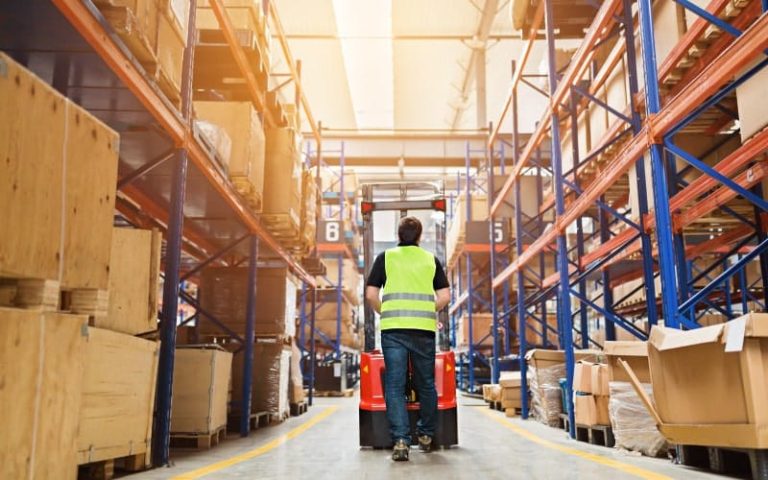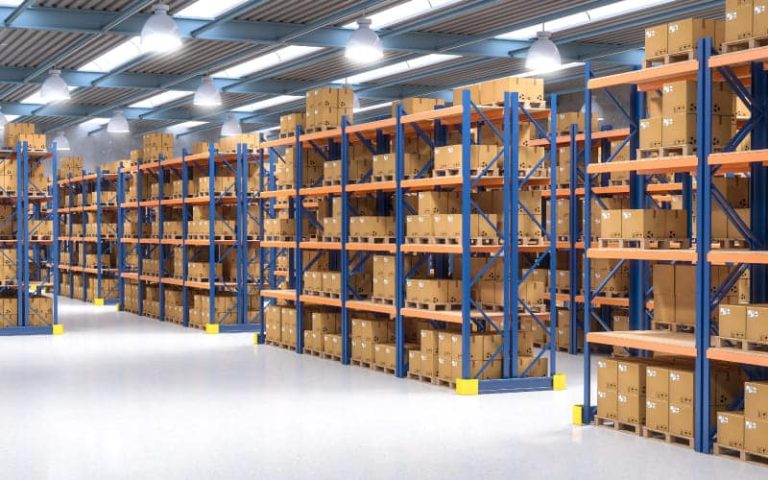Are you thinking about expanding your warehouse? Reconfiguring your workflow? Building from scratch? You have plenty of options for industrial pallet racking, but how do you find the best industrial pallet racks for sale? Here is the information you need, the key factors to consider before purchasing, and the importance of the right partner to help equip your warehouse.
We will answer your questions, starting with the different types of pallet rack solutions and how to find the right fit for you.
What Is the Most Widely Used Pallet Racking System?
The most common industrial pallet racking system is selective pallet racking, also known as adjustable pallet racking (APR).
Selective pallet racking is popular for several reasons:
- Versatility: It can accommodate various pallet sizes and weights.
- Accessibility: Each pallet is directly accessible, allowing for easy stock rotation.
- Cost-effectiveness: It’s generally less expensive than other racking systems.
- Flexibility: The layout can be easily modified to adapt to changing storage needs.
A typical selective pallet racking system consists of upright frames, beams, and safety components such as frame protectors and row spacers. This system allows forklifts to access pallets from the aisle, making it ideal for warehouses with a high turnover of goods. For example, an eCommerce fulfillment center might use selective pallet racking to store a wide variety of products from small electronics to larger household items. The ability to adjust beam levels allows for optimizing space for different product sizes while maintaining easy access for order picking.
Other Types of Industrial Pallet Racks
While selective pallet racking is the most common, several other types of industrial pallet racks cater to specific storage needs:
Drive-In/Drive-Through Racking
- Ideal for high-density storage of uniform products
- Faciliatates forklifts driving directly into the rack structure
- Best for LIFO (Last-In-First-Out) inventory management
Push-Back Racking
- Offers high-density storage with better selectivity than drive-in racks
- Uses inclined rails and carts to push pallets back as new ones are loaded
- Suitable for LIFO inventory management with multiple SKUs per lane
Pallet Flow Racking
- High-density system using gravity-fed rollers
- Ideal for FIFO (First-In-First-Out) inventory management
- Perfect for perishable goods or products with expiration dates
Cantilever Racking
- Designed for long, awkward items like lumber, pipes, or furniture
- Features arms extending from a central column, allowing for flexible storage
Stack Racks
- Stackable storage solution for various warehouse needs
- Can be used with or without pallets for flexible storage options
- Ideal for seasonal inventory or temporary storage requirements
What Are the OSHA Regulations for Pallet Racking?
The Occupational Health and Safety Administration (OSHA) requires all employers to provide a workplace that is safe and free from hazards.
OSHA recommends following industry standards set by organizations like the Rack Manufacturers Institute (RMI) and the American National Standards Institute (ANSI). These standards cover such items as:
- Load Capacity: Racks must be capable of safely supporting the required load.
- Proper Installation: Racking must be installed according to manufacturer specifications.
- Regular Inspections: Periodic inspections are needed to identify and address any damage or wear.
- Employee Training: Workers must be trained in proper loading techniques and safety procedures.
- Signage: Post load capacity signs on racking to prevent overloading.
- Protection: Install column protectors and end-of-aisle guards to prevent damage from forklifts.
OSHA Fines and Violations
Failing to comply with OSHA standards can result in significant fines. Serious violations can result in penalties of $16,131 per violation. Failing to address violations can raise the cost to that amount for every day. Willful or repeated incidents are 10 times as costly, up to $161,323 per violation.
OSHA is particularly attentive to safety in warehouses, and for good reason. Accidents and injuries in warehouses are among the highest of any industry. According to the Bureau of Labor Statistics, accidents occur at a rate of five for every 100 workers annually.
Whether you are using new or used pallet racking, light-duty or heavy-duty pallet racking, or other material handling equipment, ensuring compliance is crucial. Some of the more common fines over the past few years have been for:
- Improper Setup: Pallet racks must be correctly installed according to manufacturer guidelines. Failing to securely anchor posts and braces is a safety hazard and violates regulations.
- Structural Damage: Warehouses often see equipment wear, including pallet racks hit by forklifts. Promptly address any dents, dings, or warped metal to maintain rack integrity and ensure worker safety.
- Unauthorized Alterations: Replacing damaged cross members with makeshift parts or using non-standard fasteners is dangerous. These DIY fixes violate OSHA standards and compromise rack stability.
- Missing Load Capacity Signage: Clearly display manufacturer-specified weight limits on all racks. This crucial information helps prevent overloading, reducing the risk of rack failure and potential injuries.
Can You Install Pallet Racking Yourself?
You can install industrial pallet racks yourself, but you are taking a significant risk. If an accident occurs, you will have significant liability, especially if any mistakes were made during installation. So, it is recommended that you hire warehouse installation experts whether you are buying new pallet racks or used pallet racking near you.
Depending on your warehouse design, proper installation can be complex. Professional installers have the tools and knowledge they need to handle your project efficiently and safely. If problems arise during installation, they have the expertise to find solutions.
Safety is paramount in warehouses. Improper installation of industrial pallet racks can create significant hazards, including serious injuries or fatalities. Other concerns include:
- Compliance: DIY installations may not account for all of the local building codes or OSHA requirements.
- Warranty: Self-installation often voids any remaining warranties on used racking.
- Efficiency: Experienced installers will complete the installation faster, getting you back to work quickly and limiting disruptions.
DIY efforts often stall in the design and permitting process. Since approval can take weeks or months, you will want to work with professional engineers to produce stamped engineering documents and aid in the permitting process. This can accelerate approval and avoid mistakes that can create rework and add several months to the approval process.
How to Choose the Right Industrial Pallet Racking for Your Warehouse
When choosing used industrial pallet racking, there are several key factors you should consider to make the best choice.
Storage Needs
Start by assessing your storage requirements. This involves evaluating the types of products you’ll be storing, the sizes and weights of the pallets you’ll be using, and the total storage capacity you need.
Understanding these elements will help you determine which racking system will best accommodate your inventory and maximize your available space.
Warehouse Layout
Once you’ve determined your storage needs, it’s time to consider your warehouse design and layout. This includes analyzing your available floor space, ceiling height, and the necessary aisle width for your forklifts to operate safely and efficiently.
The layout of your warehouse will significantly influence the type and configuration of racking you can install, so it’s crucial to have a clear understanding of any constraints. Depending on what you are storing and how often you need to access your inventory, there are several different types of designs you may want to consider.
Inventory Management System
Your inventory management approach plays a vital role in selecting the right racking system. Do you operate on a FIFO or LIFO basis? How frequently do you rotate stock? What are your typical pick rates and accessibility needs?
Different racking systems cater to different inventory management strategies, so aligning your choice with your operational methods is essential for optimal efficiency.
Budget
One of the big benefits of used industrial pallet racks is the cost savings you get compared to buying new equipment. However, you need to evaluate the initial cost and any expenses for design and engineering, installation, and maintenance. You need to balance the cost-effectiveness of used racking against the quality and longevity.
While you can often find used heavy-duty pallet racking that has plenty of years of life left, you want to make sure you consider the total cost of operation and the length of time before you will have to replace it, when thinking about your budget.
Condition
When opting for used pallet racking, the condition of the equipment becomes a critical factor, and it is easy to get burned.
You have to assess the age and wear of the components and ensure they comply with current safety standards. Verify the availability of replacement parts or add-ons. Taking extra time to perform due diligence will help prevent safety hazards and costly replacements down the line.
Scalability
As your business grows, your storage needs may change. Therefore, it’s wise to consider the potential for future growth when selecting your racking system. Look for options that offer flexibility and are compatible with other racking systems. This can save you considerable time and expense in the future if you need to expand or reconfigure your storage setup.
Local Regulations
Do not overlook local regulations that may impact your racking installation. This includes adhering to building codes and meeting seismic requirements, especially in earthquake-prone areas. Compliance with these regulations is a legal necessity and critical for the safety of your employees and the protection of your inventory.
Get Expert Advice
As you can see, buying used industrial pallet racks is about more than just looking online for “used pallet racking near me.” The experts at Conesco Storage System carry a large inventory of new and used material handling equipment, including all types of storage racks. As you consider your options, talk to the Conesco Storage System team to help you find exactly what you need.
Conesco Storage Systems also provides a range of services, including:
- Design and layout
- Stamped engineering documents
- Help with permitting
- Equipment selection
- Delivery and installation
Finding the Best Industrial Pallet Racks for Sale
Regarding the best industrial pallet racks for sale, you want to find a company that has significant experience in the material handling and storage business.
You want to find a company that handles a significant volume of warehouse equipment needs and has positive reviews. For example, the warehouse storage experts at Conesco Storage Systems have more than 400 years of combined experience in designing, planning, and installing warehouse equipment.
As one of the nation’s largest warehouse liquidators, Conesco Storage Systems has a regular supply of quality used pallet racking and a team of warehouse professionals to handle the logistics and installation.
Suppliers with a large and diverse inventory are more likely to fit your needs. Conesco Storage Systems sells new and second-hand equipment ranging from pallet racks and conveyors, all of the way up to heavy industrial machinery such as lifts, balers, truck loaders, and more. Our team of architects, engineers, and construction experts is ready to help. We’ll work with you from the beginning to design a custom solution that fits your business.
Frequently Asked Questions — FQs
What is the most common pallet rack size?
The most common pallet rack size is designed to accommodate standard 48″ x 40″ pallets. Typical dimensions for selective pallet racking include:
- Upright frames: 8 to 20 feet high
- Beams: 8 to 12 feet long
- Bay width: Approximately 9 feet (allowing for overhang)
- Bay depth: Usually 42 inches for single-deep racking
However, racking can be customized to fit various pallet sizes and warehouse configurations.
What is the alternative to a pallet rack?
Depending on your storage needs, there are options including:
- Shelving Systems: Suitable for smaller items or hand-loaded products.
- Mezzanines: Create additional floor space within your existing warehouse.
- Automated Storage and Retrieval Systems (AS/RS): High-density storage with robotic retrieval.
- Vertical Lift Modules: Enclosed systems with trays that move vertically.
Conesco Storage Systems can help you with alternative storage solutions and automation as well.
How do I determine the weight capacity of used pallet racking?
Start by checking for capacity labels on beams and uprights and consulting any available original documentation from the manufacturer. If this information is unavailable, it’s crucial to have a professional racking expert or structural engineer assess the system. They can measure components, compare them to manufacturer charts, and do load-testing calculations to ensure safe operation.
Where you buy used industrial pallet racking makes a big difference. Avoid costly mistakes. Work with the warehouse equipment experts at Conseco Storage Systems. Get high-quality used industrial pallet racks and everything you need for an efficient warehouse. Call Conesco Storage Systems at (303) 690-9591 or request a consultation online.



